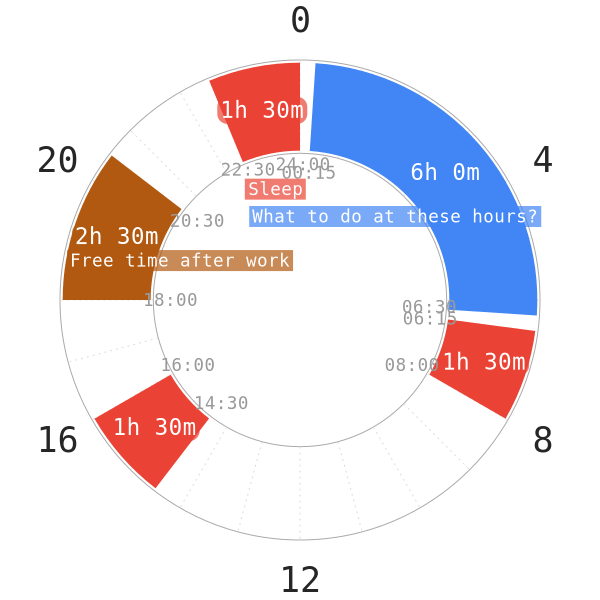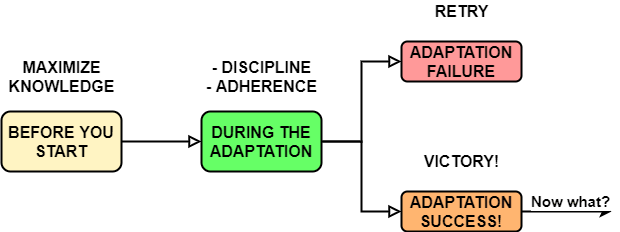Introduction
Starting a polyphasic lifestyle is nothing to laugh at. Even though the schedules and rules look simple on paper, you should in no way bastardize the process. Things may look as simple as: “No oversleeping”, “sleep at the same times everyday”, but there is much more!

While you may not need to follow every single step in this guide to succeed with your attempt, this is a compilation of action sequences from the most experienced community members. Thus, these tips may help you out more than you think they do! But first, let’s take a look at polyphasic sleeping’s lifestyle.
Introduction to Polyphasic Sleep
Polyphasic sleep is the practice of sleeping more than once per day1,2. This contrasts with monophasic sleep, which consists of a single sleep block. In today’s (western) society, monophasic sleep is the most dominant sleep pattern.
- Sleeping more than once per day may initially sound strange or abnormal. However, it is quite common. In fact, our monophasic sleep cycle is a learned behavior.
- About 85% of mammals follow polyphasic sleep cycles.
- Human babies start life with polyphasic sleep; the elderly also revert to polyphasic sleep.
- Before the advent of artificial (electric) lighting, the vast majority of humanity followed a polyphasic sleep schedule3,4. These polyphasic sleep schedules generally take the form of a siesta near the equator and transition to segmented as nights lengthened further away.
Throughout history, there are references to polyphasic sleeping as a “first sleep” in the early evening and “second sleep” during early morning. There are also several hours of waking in between3. This wake period was dedicated to various activities. Examples include, but not limited to, praying, writing, having sex and interpreting dreams.
The introduction of artificial lighting caused changes in our natural circadian rhythm. This results in a predominant monophasic pattern people slept since. In a more extreme way, most of modern society has forgotten that our ancestors slept this way5.
Flowchart Guide
Refer to the flowchart below for what you should do before you begin your polyphasic attempt.

- Gather as much information about polyphasic sleep as you can.
- Figure out which schedules are suitable for you and your sleep needs.
- Determine which schedule you would prefer to try. Lifestyle considerations, medical cautions and scheduling has more information about this.
- Prepare for the adaptation period to the best of your ability.
- Map out your activities that would boost your morale and wakefulness during tough adaptation stages.
Gathering information is particularly important. You should definitely make sure the information comes from reputable sources. This is because way too many people try polyphasic sleeping with a lack of accurate data and have no idea what they are doing. This will very often lead to failure. Thus, this website attempts to provide an exhaustive compilation of available information in other pages you will find.
In addition, there is anecdotal information from long-term successful polyphasers and thousands of attempters from Reddit and Discord. Some individuals even have sleep tracking devices. Therefore, you should be able to learn about pretty much everything necessary to succeed with the polyphasic lifestyle. Best of luck with your journey!
Main author: Crimson & GeneralNguyen
Page last updated: 22 January 2021
Reference
- “Definition of POLYPHASIC.” Www.merriam-Webster.com, www.merriam-webster.com/dictionary/polyphasic. Accessed 28 Jan. 2021.
- Idzikowski, Chris. You Can Sleep Well: Change Your Thinking, Change Your Life. Watkins Media Limited, 2015.
- Ekirch AR. Segmented Sleep in Preindustrial Societies. Sleep. 2016;39(3):715-716. doi:10.5665/sleep.5558. [PubMed]
- Napping. National Sleep Foundation. https://www.sleepfoundation.org/sleep-topics/napping. Published 2018. Accessed November 4, 2018.
- Wehr T. The durations of human melatonin secretion and sleep respond to changes in daylength (photoperiod). J Clin Endocrinol Metab. 1991;73(6):1276-1280. [PubMed]
